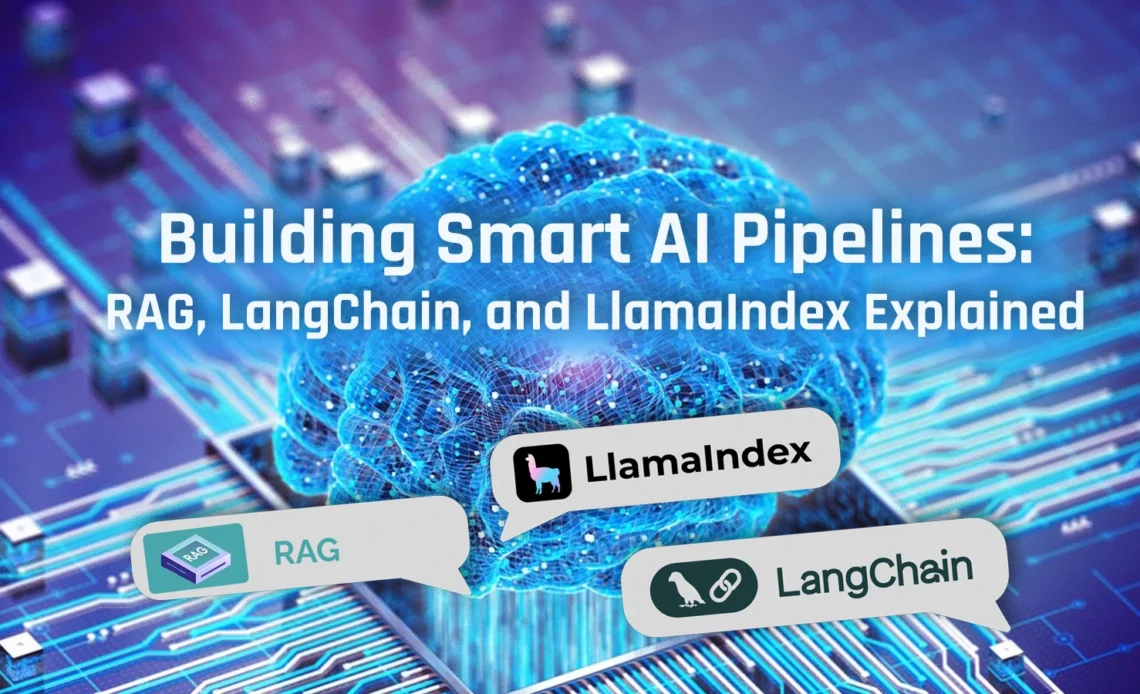Technologies like RAG, LangChain, and LlamaIndex are quietly powering some of the most impactful GenAI applications in enterprise today. Together, they form the nervous system that makes large language models not just smart, but useful.
Introduction: Models Don’t Scale. Systems Do.
We often hear that Generative AI is revolutionizing business. But the untold truth? The model alone is not the revolution.
You can fine-tune GPT. You can experiment with Falcon or LLaMA. But unless you architect a system around these models — one that connects them to your business logic, your proprietary data, and your execution workflows — you’re building an island. Not an engine.
That’s where smart AI pipelines come in.
Technologies like RAG, LangChain, and LlamaIndex are quietly powering some of the most impactful GenAI applications in enterprise today. Together, they form the nervous system that makes large language models not just smart, but useful.
This isn’t about hype. It’s about engineering clarity.
RAG: Retrieval-Augmented Generation — The Antidote to Hallucinations
Imagine asking your team’s best analyst for a report, and they improvise based on memory. That’s what most LLMs do.
RAG fixes that. It gives your AI the ability to search relevant documents and cite real knowledge before answering.
Here’s how it works:
- You ask a question.
- The system searches your internal database.
- It retrieves the most relevant documents.
- The LLM uses these documents as grounding before responding.
✅ Why this matters?
- You reduce hallucinations.
- You get answers rooted in your company’s truth.
- You extend the life and utility of your AI models without constant retraining.
RAG transforms GenAI from a guesser into a researcher. That’s a fundamental shift in trust and accuracy.
LangChain: The Orchestrator That Makes Everything Work Together
If RAG is your AI’s researcher, LangChain is the project manager.
It doesn’t generate text or analyze data — it coordinates all the tools in your stack. It connects your AI model to your APIs, databases, and business workflows, and tells it how to move step-by-step through a logic chain.
Think of it like middleware — but made for reasoning.
LangChain allows you to:
- Design multi-step reasoning workflows
- Build “agent-like” behaviors (e.g., AI that asks follow-up questions or calls APIs)
- Connect multiple tools in a flow — from database queries to web searches to summarization
The takeaway: LangChain makes GenAI applications modular, repeatable, and dynamic.
You’re no longer coding a bot. You’re designing a thinking system.
LlamaIndex: The Bridge to Your Real-World Data
Most businesses sit on oceans of data — PDFs, SQL databases, CRM exports, internal wikis. Traditional LLMs can’t access this data meaningfully. They weren’t trained on your business.
Enter LlamaIndex.
It takes all that unstructured (or structured) data and indexes it in a way that makes it searchable and usable by an LLM.
Imagine uploading a year’s worth of internal training guides, and your AI can now answer employee questions, onboard new hires, or generate FAQs — all from your actual knowledge base.
LlamaIndex transforms static data into dynamic intelligence.
You’re no longer training a model from scratch. You’re connecting one to your world.
How It All Comes Together: The Modern GenAI Stack
Let’s connect the dots.
A scalable, intelligent GenAI application looks like this:
- LlamaIndex ingests and indexes your enterprise data
- RAG retrieves the most relevant knowledge chunks in response to a query
- LangChain orchestrates the prompt, routes tools, and handles external integrations
- Your LLM processes everything and returns a contextual, grounded answer
This architecture lets you move beyond chatbots into territory like:
- Executive assistants for your leadership team
- Intelligent proposal generators for your sales org
- Domain-specific copilots for legal, finance, or HR
- Customer service agents with instant recall of product history and documentation
This is not just AI that talks. It’s AI that thinks with you.
Industry Examples: What This Looks Like in Action
Legal: A law firm builds a RAG-based assistant using LangChain and LlamaIndex to summarize case law and compare it with internal policies — reducing research time by 70%.
Healthcare: A provider uses LlamaIndex to ingest clinical trial data. A fine-tuned model then uses RAG to surface relevant protocols in response to doctor queries — all orchestrated via LangChain.
B2B SaaS: A growth-stage company builds an AI sales assistant that auto-generates proposals based on client history, industry trends, and prior templates — updated in real time.
Each of these examples is powered not just by a model, but by an intelligent, flexible pipeline.
Leadership Insight: Don’t Just Deploy Models — Architect Intelligence
This is where AI maturity is heading. It’s no longer enough to pilot a tool.
Leaders need to ask:
- Are we grounding our AI in our own knowledge?
- Can our AI explain its reasoning?
- Are we integrating AI into our systems, not just around them?
RAG, LangChain, and LlamaIndex are not niche tools. They are the architecture of enterprise-grade AI.
In the future, competitive advantage won’t just come from who has the best model — but from who builds the smartest pipeline.
Conclusion: Build Systems That Learn With You
In the end, this isn’t about acronyms. It’s about adaptability.
The companies that win with AI won’t be the ones chasing the next release of GPT or LLaMA. They’ll be the ones who treat AI like infrastructure, not a feature — who architect systems that learn, reason, and respond in line with their business.
If you’re serious about deploying AI that does more than chat — start building your pipeline.
Lesson: The future is not model-centric. It’s architecture-led. And that future starts now.


